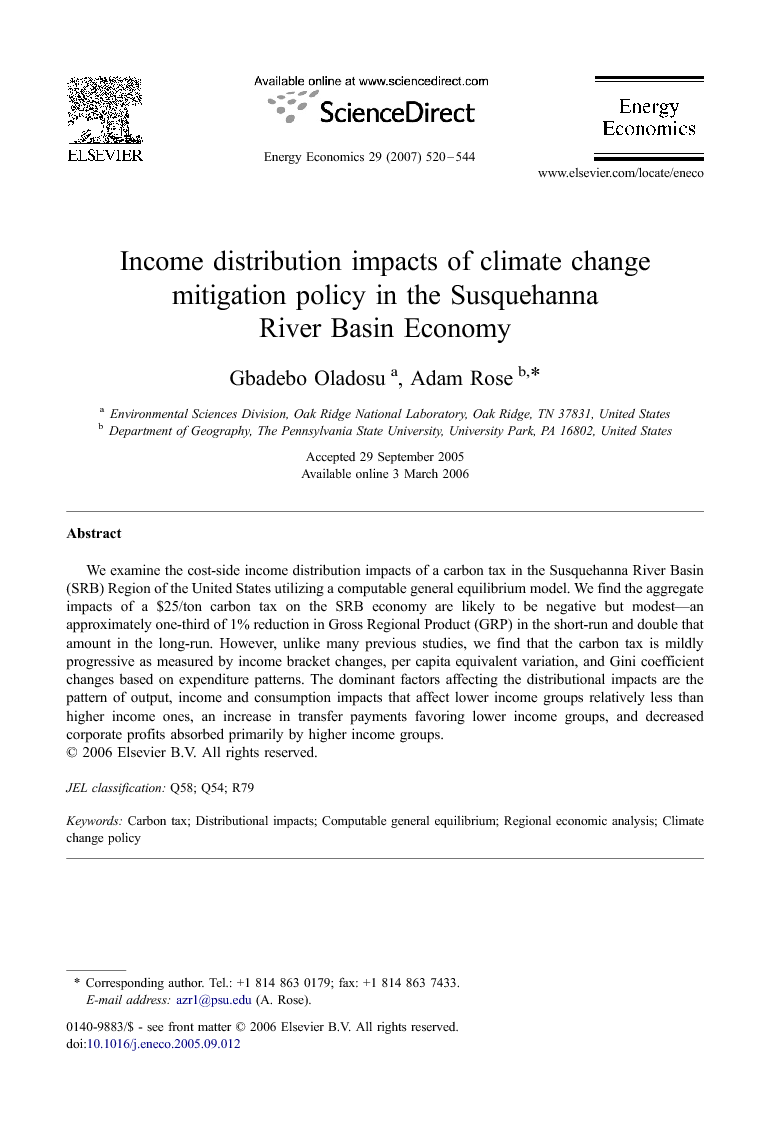We examine the cost-side income distribution impacts of a carbon tax in the Susquehanna River Basin (SRB) Region of the United States utilizing a computable general equilibrium model. We find the aggregate impacts of a $25/ton carbon tax on the SRB economy are likely to be negative but modest—an approximately one-third of 1% reduction in Gross Regional Product (GRP) in the short-run and double that amount in the long-run. However, unlike many previous studies, we find that the carbon tax is mildly progressive as measured by income bracket changes, per capita equivalent variation, and Gini coefficient changes based on expenditure patterns. The dominant factors affecting the distributional impacts are the pattern of output, income and consumption impacts that affect lower income groups relatively less than higher income ones, an increase in transfer payments favoring lower income groups, and decreased corporate profits absorbed primarily by higher income groups.
Mitigating the potentially dramatic impacts of climate change is one of the leading environmental policy concerns of the 21st Century. Since the combustion of fossil fuels is the largest single source of greenhouse gases in industrialized countries, carbon taxes and carbon emission permits are at the forefront of instrument design in this era of incentive-based policies (Weyant and Hill, 1999 and Rose and Oladosu, 2002). While promising a cost-effective solution, the macroeconomic impact of implementing these instruments is, however, predicted to be negative for most policy designs. For example, the latest Intergovernmental Panel on Climate Change Report (IPCC, 2001) identifies a likely range of impacts from − 0.2% to − 2.0% of GDP to meet Kyoto emission targets.1
The distribution of the cost burden of climate change mitigation policies, like that of nearly all environmental and energy policies, will inevitably be uneven within and across the categories of households and businesses (Rose et al., 1988). The benefits of these policies (avoided damages of climate change) are distributed unevenly as well, and in a different manner than the cost (see, e.g., Oladosu, 2000). Although dozens of studies have investigated potential aggregate economic impacts of climate change policy (see, e.g., Weyant and Hill, 1999 and IPCC, 2001), very few have examined their distributional impacts.
The purpose of this paper is to analyze the cost-side income distribution impacts of a carbon tax in the Susquehanna River Basin (SRB) Region of the United States. We utilize a computable general equilibrium (CGE) model specially constructed for this purpose in terms of conceptual design and detailed empirical specification of income and consumption relationships (see Oladosu, 2000). The analysis is undertaken at the regional level for two major reasons. First, climate change impacts, a major driver of the pace and shape of mitigation policy, are likely to vary by region in a large country such as the U.S. Moreover, climate impacts are not likely to conform to sub-national political boundaries but rather to major ecosystems, a notable example being a watershed. Second, implementation of climate change mitigation policy will take place at the regional and local levels. In any effort to match remedies to problems in general, and to match beneficiaries to cost-payers in particular, a regional approach will be necessary and will likely shift attention away from artificial boundaries like political jurisdictions (see, e.g., Easterling, 1997).23
Distributional impacts are important for two reasons. First, from a normative standpoint, previous studies have generally found carbon taxes to be regressive (i.e., to place a disproportionate burden on lower income groups). This is important from the standpoint of equity, or fairness, in its own right. Second, for more pragmatic reasons, the distribution of impacts is important for policy formation and viability, since groups negatively impacted can mobilize opposition (Olson, 1965 and Rose et al., 1988). Bovenberg et al. (2005) have pointed out that businesses are likely to have more clout than consumers in this regard. However, accelerating concern about environmental justice (broadly defined)4 draws attention to lower income and minority households, and effectively mobilizes opposition on their behalf.
In contrast to many previous studies, we found a carbon tax to be progressive in terms of its impacts on the size distribution of personal income. This result stems from several explanatory factors, but the dominating one is a pattern of output, income, and consumption impacts that affect lower income brackets relatively less than higher brackets. This is reinforced by an increase in transfer payments, which favors lower income groups, and decreased corporate profits, which are absorbed primarily by those in higher brackets.


